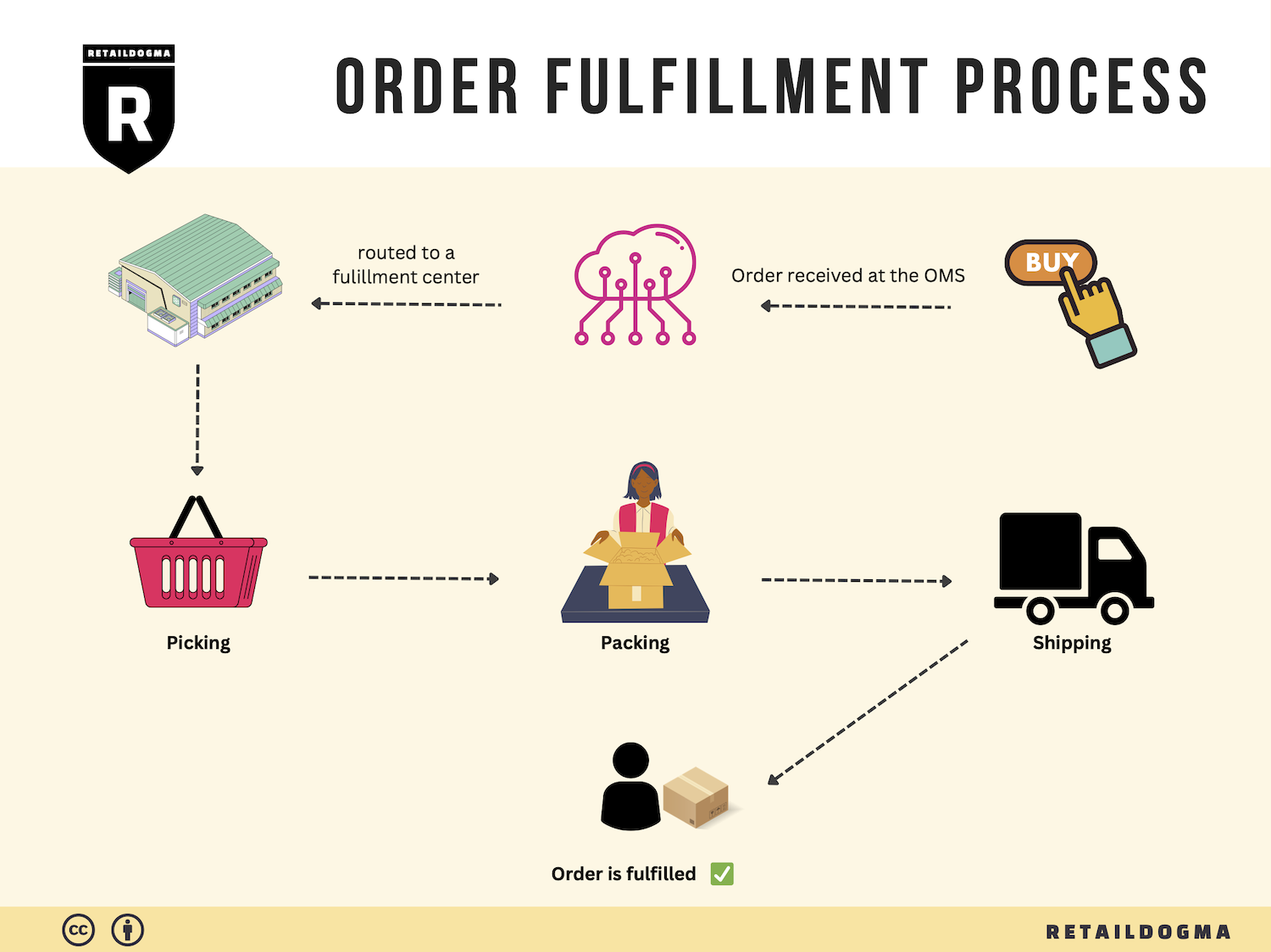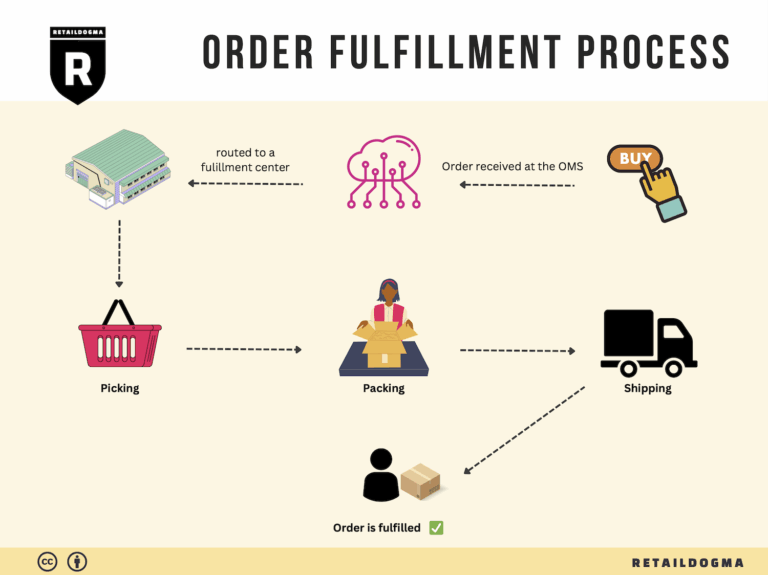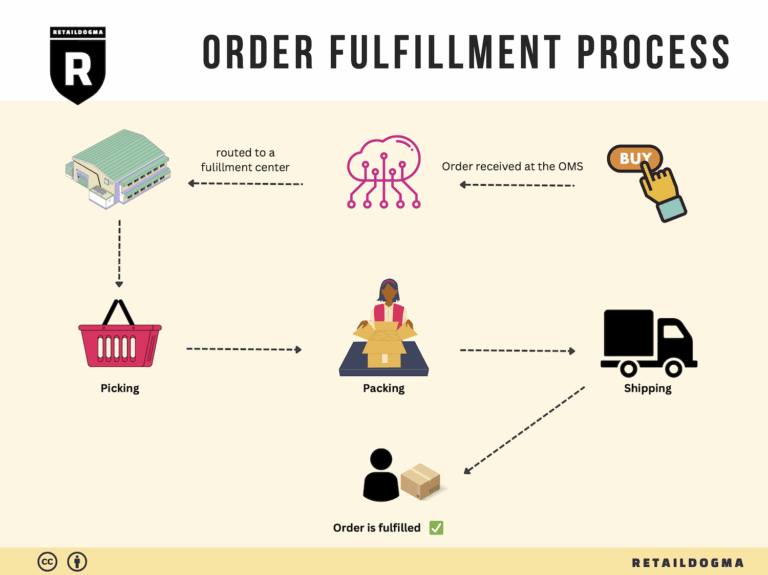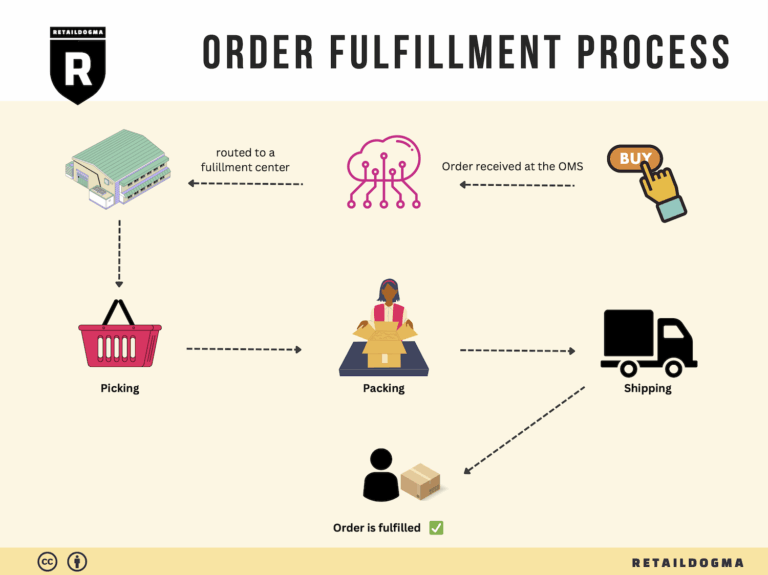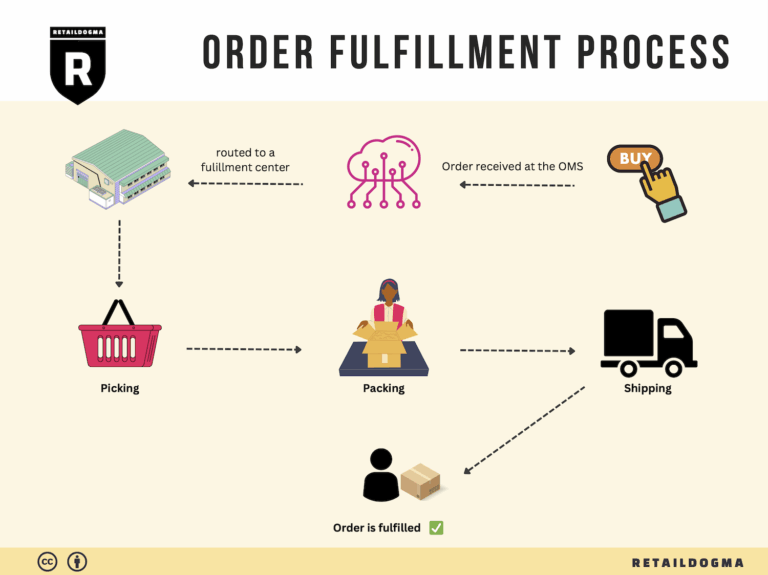How Order Fulfillment Works: A Step-by-Step Guide for Businesses
What is E-commerce Fulfillment? An Introduction for Growing Businesses
As your e-commerce business begins to grow, the excitement of increasing sales can quickly turn into overwhelm when it comes to packing and shipping orders. Many entrepreneurs find themselves buried under boxes, shipping labels, and inventory management, leading to stress and inefficiency. This is where understanding e-commerce fulfillment becomes crucial.
Understanding Fulfillment
E-commerce fulfillment is simply the process of getting a product from your warehouse or fulfillment center into the hands of your customers. This involves a series of steps, including receiving orders, picking items, packing them securely, and shipping them out. While it may seem straightforward, the logistics can become complex, especially as your order volume increases.
What This Guide Covers
In this guide, we will explore the various models of e-commerce fulfillment that can help streamline your operations. You’ll learn about:
- Third-Party Logistics (3PL): Outsourcing your fulfillment needs to specialized companies that handle storage, packing, and shipping on your behalf.
- Fulfillment by Amazon (FBA): Leveraging Amazon’s extensive logistics network to fulfill orders directly from their warehouses.
- In-house Fulfillment: Managing the entire process internally, which can offer more control but also requires significant resources.
We will also delve into the core services offered by fulfillment centers, including inventory management, order processing, and shipping options. Understanding these services will help you identify what you truly need to support your business growth.
Choosing the Right Fulfillment Partner
Selecting the right fulfillment partner is critical to your success. This guide will provide practical tips on how to evaluate potential partners based on factors like accuracy, reliability, and service offerings. We’ll also cover essential questions to ask, such as order minimums, pricing structures, and additional services like kitting or assembly.
Pricing Considerations
Lastly, we will discuss pricing models for fulfillment services, helping you understand the costs involved and how to budget effectively. As a growing business, it’s essential to know how fulfillment costs can impact your bottom line and what options are available to keep expenses manageable.
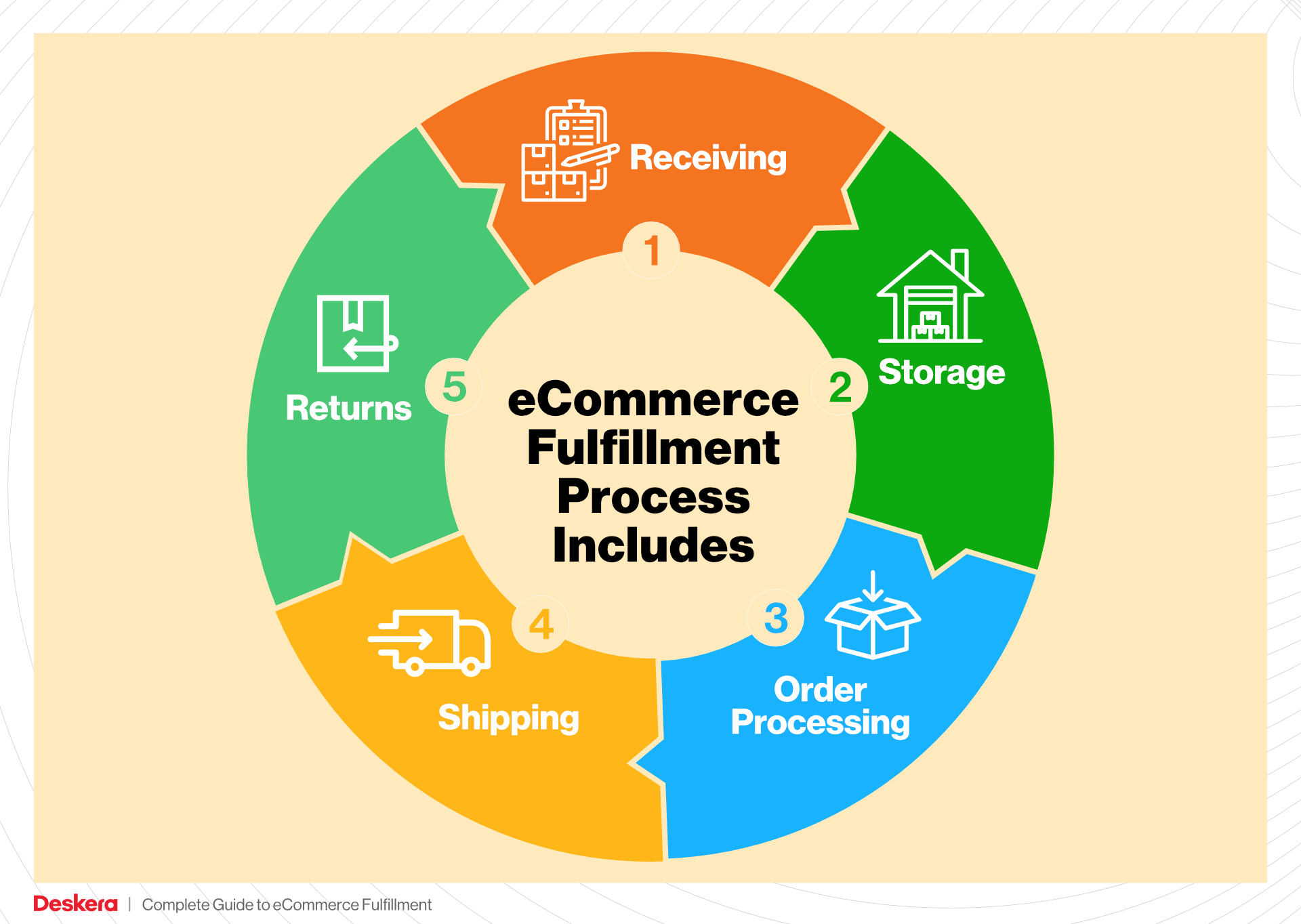
Empowering Your Business
The goal of this guide is to empower you, the business owner, with the knowledge and tools needed to make informed decisions about your logistics strategy. By understanding the nuances of e-commerce fulfillment, you can focus on scaling your business while ensuring that your customers receive their orders promptly and accurately. Let’s dive in and transform your fulfillment process into a seamless part of your e-commerce operation.
What You’ll Learn In This Guide
- What is E-commerce Fulfillment? An Introduction for Growing Businesses
- The Order Fulfillment Process: From ‘Buy’ Button to Customer’s Door
- Comparing Fulfillment Models: In-House vs. 3PL vs. Dropshipping
- A Deep Dive into Amazon FBA: Pros, Cons, and Who It’s For
- Core Services Offered by Fulfillment Centers
- How to Choose a Fulfillment Partner: A 6-Point Checklist
- Understanding Fulfillment Pricing: A Breakdown of Common Fees
- Frequently Asked Questions (FAQs) about Fulfillment
- Conclusion: Is Outsourcing Fulfillment the Right Move for Your Business?
- Important Disclaimer
The Order Fulfillment Process: From ‘Buy’ Button to Customer’s Door
1. Receiving Inventory
The first step in the order fulfillment process is receiving inventory. When products arrive at the fulfillment center, they must be carefully logged into the inventory management system. This process typically involves checking the shipment against purchase orders to ensure accuracy and quality. Each item is assigned a Stock Keeping Unit (SKU), which is a unique identifier that helps in tracking products throughout the fulfillment process.
This step is critical for several reasons. First, accurate receiving prevents discrepancies in inventory levels, which can lead to stockouts or overstock situations. Second, it establishes a clear record of what is available for sale, enabling better inventory management and forecasting. Effective receiving processes can significantly enhance operational efficiency and customer satisfaction by ensuring that products are available when needed.
2. Warehouse Storage
Once the inventory is received and logged, it is stored in the fulfillment center. Efficient warehouse storage involves organizing products in a way that maximizes space and improves accessibility. This often includes categorizing items based on their type, size, or sales velocity, and utilizing a systematic approach like FIFO (First In, First Out) or LIFO (Last In, First Out) depending on the nature of the products.
Proper storage is essential because it directly impacts order picking speed and accuracy. If products are stored haphazardly, it can lead to delays and errors during the picking process. Additionally, well-organized storage can enhance the overall safety of the warehouse by minimizing clutter and reducing the risk of accidents. Implementing an effective warehouse management system (WMS) can help streamline this step by providing real-time visibility into stock levels and locations.
3. Order Picking
Order picking is the process of selecting items from the warehouse to fulfill a customer’s order. When a customer places an order, a pick list is generated, detailing the items and their locations within the warehouse. Warehouse staff or automated systems then retrieve these items, ensuring that the correct products are selected in a timely manner.
This step is crucial as it directly affects order accuracy and fulfillment speed. Mistakes in picking can lead to incorrect shipments, resulting in customer dissatisfaction and increased returns. Moreover, optimizing picking routes can significantly reduce the time it takes to fulfill an order. Techniques such as batch picking (picking multiple orders at once) or zone picking (assigning pickers to specific areas) can enhance efficiency and reduce labor costs.
4. Order Packing
After items have been picked, they move to the packing station. During this phase, products are carefully packed into boxes or envelopes, ensuring that they are protected during transit. Packaging materials such as bubble wrap, packing peanuts, or air pillows may be used to prevent damage. Additionally, packing slips are often included to provide customers with order details.
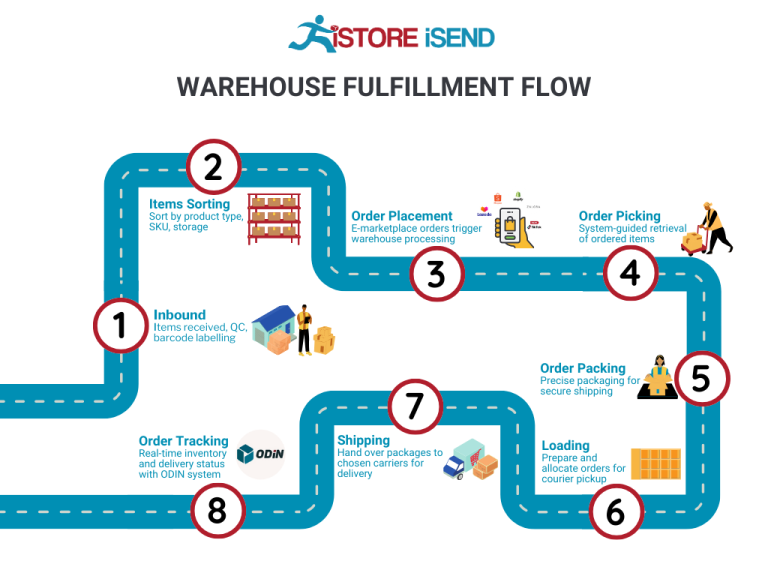
The packing step is vital as it ensures that products arrive at the customer’s door in pristine condition. Proper packing not only reduces the risk of damage during shipping but also enhances the overall unboxing experience for customers. Efficient packing processes can minimize shipping costs by optimizing box sizes and reducing dimensional weight, which is crucial in today’s competitive e-commerce landscape.
5. Shipping & Delivery
The final step in the fulfillment process is shipping and delivery. Once orders are packed, they are handed over to shipping carriers for delivery to customers. This step involves generating shipping labels, scheduling pickups, and tracking shipments to ensure timely delivery. Many fulfillment centers offer various shipping options, including expedited services, to meet diverse customer needs.
Shipping is a critical component of customer satisfaction and can significantly influence repeat purchases. Delays or issues in shipping can lead to negative customer experiences, impacting your brand’s reputation. Therefore, it is essential to choose reliable carriers and establish clear communication with customers regarding tracking and delivery timelines. Using a robust shipping software solution can streamline this process, providing real-time tracking and notifications that enhance the overall customer experience.
In conclusion, mastering the order fulfillment process is essential for e-commerce businesses aiming to scale efficiently. By understanding and optimizing each step—from receiving inventory to shipping and delivery—business owners can enhance operational efficiency, reduce costs, and ultimately improve customer satisfaction.
Comparing Fulfillment Models: In-House vs. 3PL vs. Dropshipping
Fulfillment Model Comparison
| Model | Who Handles Inventory | Best For (Business Stage) | Key Advantage | Key Disadvantage |
|---|---|---|---|---|
| In-House Fulfillment | The business itself | Startups and small businesses | Full control over processes and quality | Resource-intensive and high overhead costs |
| Third-Party Logistics (3PL) | A third-party fulfillment provider | Growing and scaling businesses | Cost-effective and scalable solutions | Less control over fulfillment processes |
| Dropshipping | Suppliers or manufacturers | New and niche businesses | Low upfront investment and risk | Lower profit margins and potential delays |
In-House Fulfillment
In-house fulfillment refers to the process where a business takes full responsibility for managing its inventory and order fulfillment. This model is often favored by startups and small businesses that wish to maintain complete control over their operations. By managing fulfillment in-house, businesses can establish their own quality standards, streamline processes, and gain deeper insights into inventory management. However, this model can be resource-intensive, requiring significant investments in warehousing, technology, and staffing. Furthermore, as businesses grow, the cost of maintaining an in-house operation can escalate quickly, particularly with rising warehouse storage costs. Companies must also consider the scalability of their operations; what works for a small volume of orders may not be feasible as order volumes increase.
Third-Party Logistics (3PL)
Third-party logistics, or 3PL, involves outsourcing fulfillment operations to specialized companies that handle warehousing, picking, packing, and shipping of products on behalf of e-commerce businesses. This model is particularly advantageous for growing and scaling businesses that need to optimize their logistics without the high overhead associated with in-house fulfillment. 3PL providers typically have advanced technology and logistics networks, allowing businesses to leverage their expertise for improved efficiency and cost savings. Additionally, businesses can benefit from flexibility, as 3PLs can scale operations up or down based on demand fluctuations. However, one of the main drawbacks is that businesses may have less control over the fulfillment process, which can lead to challenges in maintaining consistent quality and customer experience. It’s crucial for businesses to choose a reliable 3PL partner that aligns with their operational needs and customer service standards.
Dropshipping
Dropshipping is a fulfillment model where the retailer does not hold inventory but instead partners with suppliers or manufacturers who ship products directly to customers on behalf of the retailer. This model is particularly appealing to new and niche businesses looking to enter the market with minimal upfront investment. Since dropshipping eliminates the need for inventory storage and management, it significantly reduces financial risk and allows entrepreneurs to focus on marketing and sales strategies. However, the dropshipping model comes with its own set of challenges. Retailers often face lower profit margins due to reliance on suppliers for fulfillment, which can also introduce potential delays in shipping and product availability. Additionally, the lack of control over inventory and shipping processes can lead to issues with customer satisfaction. For businesses considering dropshipping, it’s vital to establish strong relationships with reliable suppliers to mitigate these risks and ensure a smooth customer experience.
Conclusion
Choosing the right fulfillment model is critical for e-commerce businesses aiming to scale effectively. Each model—In-House Fulfillment, Third-Party Logistics, and Dropshipping—offers distinct advantages and disadvantages that can significantly impact operational efficiency, cost management, and customer satisfaction. Business owners must carefully evaluate their current stage, operational capabilities, and long-term goals to select the fulfillment strategy that aligns best with their vision for growth. By doing so, they can ensure that their logistics and fulfillment processes support their overall business objectives while meeting customer expectations.
A Deep Dive into Amazon FBA: Pros, Cons, and Who It’s For
Understanding Fulfillment by Amazon (FBA)
Fulfillment by Amazon (FBA) is a service provided by Amazon that allows sellers to store their products in Amazon’s fulfillment centers. Amazon then takes care of storage, packaging, and shipping, as well as handling customer service and returns. This service is particularly appealing to e-commerce businesses looking to scale efficiently while leveraging Amazon’s robust logistics network.
How FBA Works
The FBA process is straightforward and efficient, designed to streamline the selling experience for e-commerce businesses:
-
Product Listing: Sellers create product listings on Amazon and enroll in the FBA program. Each product must be eligible for FBA, which typically includes compliance with Amazon’s policies and guidelines.
-
Shipping Inventory: Sellers send their inventory to one or more of Amazon’s fulfillment centers. It is crucial to package the products according to Amazon’s specifications to avoid complications.
-
Storage: Once received, Amazon stores the products in its warehouses. Sellers are charged for storage based on the space their inventory occupies.
-
Order Processing: When a customer places an order, Amazon picks, packs, and ships the product on behalf of the seller. Orders are typically shipped within the same day if received before the cutoff time.
-
Customer Service: Amazon handles all customer inquiries and returns related to FBA orders, allowing sellers to focus on other aspects of their business.
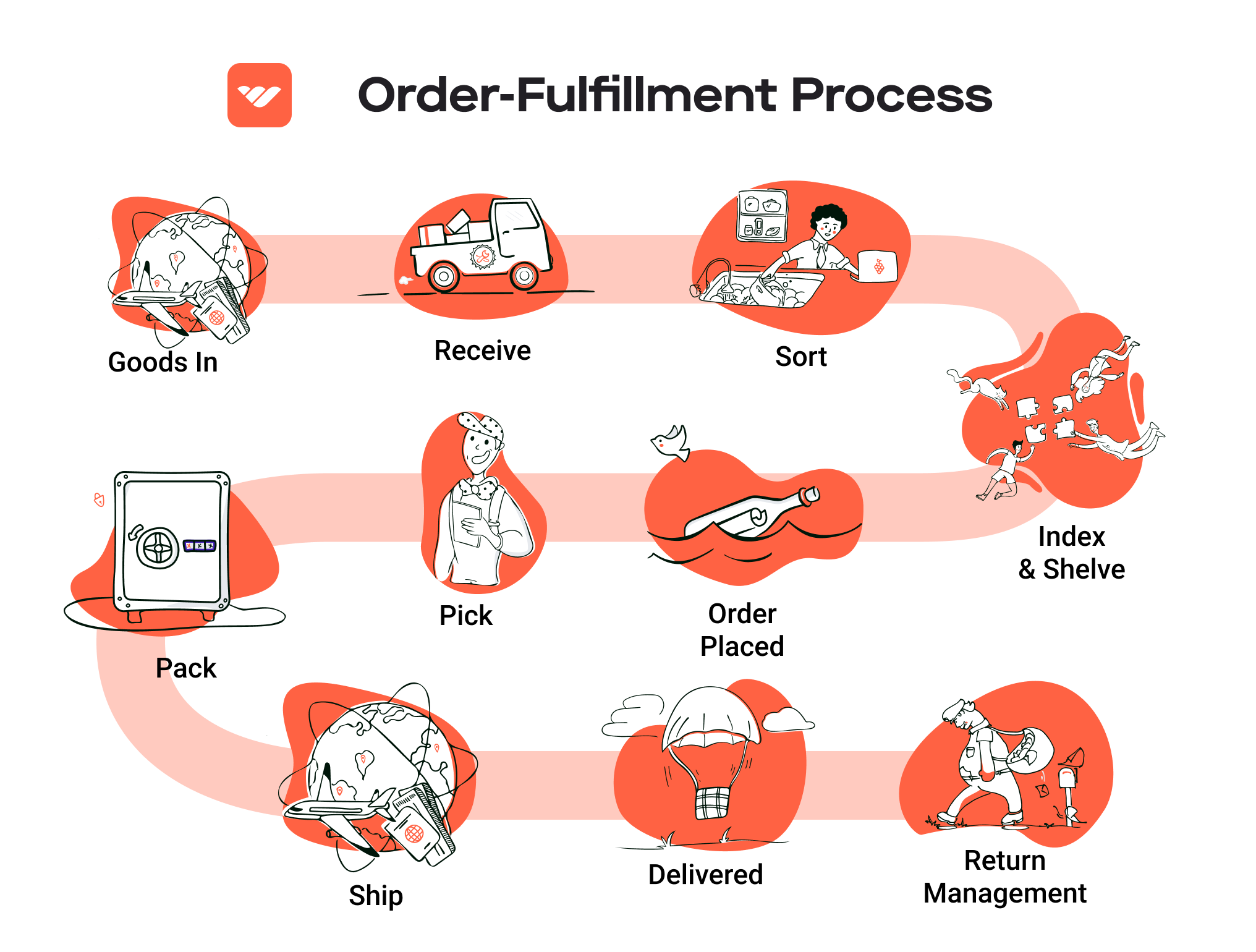
-
Payment: After the sale, Amazon deducts its fees and transfers the remaining balance to the seller’s account, typically every two weeks.
Pros of Fulfillment by Amazon (FBA)
FBA offers several advantages that can significantly enhance an e-commerce business’s operations:
-
Prime Eligibility: Products fulfilled by Amazon are automatically eligible for Amazon Prime, which attracts a vast customer base seeking fast, free shipping. This can lead to higher sales volume and visibility.
-
Customer Trust: By using FBA, sellers benefit from Amazon’s trusted brand reputation. Customers are more likely to purchase from sellers who utilize FBA because they associate it with reliable service and quality.
-
Multi-Channel Fulfillment: FBA allows sellers to use Amazon’s logistics for orders placed outside of Amazon, such as on their own websites or other e-commerce platforms. This flexibility can streamline operations and reduce fulfillment costs across different sales channels.
-
Scalability: As a business grows, FBA can accommodate increased order volumes without the need to invest in additional warehouse space or staffing. This scalability is particularly beneficial for seasonal businesses or those experiencing rapid growth.
-
Time Savings: By outsourcing fulfillment to Amazon, sellers can save significant time and resources. This allows them to focus on marketing, product development, and other strategic areas of their business.
Cons of Fulfillment by Amazon (FBA)
Despite its benefits, FBA also comes with several drawbacks that sellers should consider:
-
High Fees: FBA fees can accumulate quickly, including storage fees, fulfillment fees per unit, and additional costs for long-term storage. Sellers must carefully calculate these costs to ensure profitability.
-
Strict Inventory Rules: Amazon enforces stringent inventory management policies, including limitations on the number of units that can be stored in their warehouses. Sellers must maintain a careful inventory balance to avoid incurring excess storage fees.
-
Commingling Risks: FBA products may be commingled with other sellers’ inventory. This can lead to challenges in tracking inventory, particularly if customers receive defective products. Sellers may also face issues with returns, as they cannot verify the condition of returned items.
-
Limited Control Over Fulfillment: Once products are sent to Amazon, sellers relinquish control over the fulfillment process. This can lead to inconsistencies in packaging and shipping quality, which can impact customer satisfaction.
-
Dependency on Amazon: Relying heavily on FBA can create a dependency on Amazon’s platform. Changes in Amazon’s policies, fees, or algorithms can significantly affect a seller’s business.
Who is FBA Best For?
Fulfillment by Amazon is particularly well-suited for:
-
Small to Medium-Sized Businesses: Businesses that may not have the resources to manage their own fulfillment operations can benefit significantly from FBA’s streamlined processes and extensive logistics network.
-
Entrepreneurs Looking to Scale: For entrepreneurs aiming to grow their sales quickly without the overhead costs associated with warehousing and logistics, FBA offers a scalable solution.
-
Sellers with High Turnover Products: If you sell items that are consistently in demand, FBA can help manage inventory levels effectively while ensuring quick shipping.
-
Brands Seeking Credibility: Newer sellers or brands looking to establish credibility in the market can leverage Amazon’s reputation to gain customer trust.
-
Businesses Selling on Multiple Channels: Companies that sell through various online platforms can benefit from FBA’s multi-channel fulfillment capabilities, simplifying logistics and order management.
In conclusion, Fulfillment by Amazon can be a powerful tool for e-commerce businesses looking to scale efficiently. However, it’s essential to weigh the pros and cons carefully and consider your unique business needs and goals before diving into the program. By doing so, you can determine if FBA is the right fit for your e-commerce strategy.
Core Services Offered by Fulfillment Centers
Inventory Management & Warehousing
Inventory management and warehousing are foundational services provided by fulfillment centers, ensuring that e-commerce businesses maintain optimal stock levels and efficient storage solutions. Fulfillment centers offer dedicated spaces for storing products, which include climate-controlled environments for sensitive items and organized shelving systems for easy access.
Benefits:
1. Space Optimization: Fulfillment centers are designed to maximize storage efficiency. This allows businesses to store larger quantities of inventory without the overhead costs associated with renting and maintaining their own warehouse space.
2. Real-Time Inventory Tracking: Advanced inventory management systems enable real-time tracking of stock levels. This capability helps businesses avoid stockouts or overstock situations, ensuring that they can meet customer demand without unnecessary excess.
3. Scalability: As a business grows, its inventory needs can fluctuate significantly. Fulfillment centers provide the flexibility to scale storage capacity up or down based on demand, which is particularly advantageous for seasonal products or promotional campaigns.
Pick and Pack Services
Pick and pack services are integral to the fulfillment process, where orders are efficiently picked from inventory, packed into appropriate shipping materials, and prepared for shipment. This service is crucial for maintaining accuracy and speed in order processing.
Benefits:
1. Efficiency: Fulfillment centers utilize optimized workflows and technology to streamline the picking process. This not only reduces the time taken to fulfill orders but also minimizes the risk of errors, leading to higher customer satisfaction.
2. Customization: Many fulfillment centers offer customization options during the packing process, such as branded packaging or including promotional materials. This allows businesses to enhance the customer experience and reinforce their brand identity.
3. Cost-Effectiveness: Outsourcing pick and pack services can significantly reduce labor costs associated with hiring and training in-house staff. Fulfillment centers often operate at a scale that allows them to offer these services at a lower cost.
Kitting and Assembly
Kitting and assembly services involve the grouping of individual products into ready-to-sell sets or kits, which may require assembly. This is particularly beneficial for e-commerce businesses that sell products requiring assembly or those that offer bundled products.
Benefits:
1. Streamlined Processes: By outsourcing kitting and assembly, businesses can focus on their core operations while ensuring that their products are packaged and presented in a market-ready format. This helps in reducing time-to-market for new product launches or seasonal promotions.
2. Enhanced Product Offering: Kitting allows businesses to create unique product bundles that can increase perceived value and attract more customers. For example, a beauty retailer might offer a skincare kit that combines several products at a discounted price.
3. Inventory Management: Kitting can also help in inventory management by reducing the number of individual SKUs a business needs to track. Instead of managing multiple single items, businesses can manage fewer kits, simplifying inventory control.
Returns Management (Reverse Logistics)
Returns management, or reverse logistics, is a crucial service that deals with the return of products from customers back to the fulfillment center. Efficient handling of returns is vital for maintaining customer satisfaction and loyalty.
Benefits:
1. Customer Satisfaction: A seamless return process enhances customer trust and satisfaction. Fulfillment centers typically manage the entire returns process, from receiving returned items to restocking or disposing of them, which minimizes the hassle for the customer.
2. Data Insights: Managing returns can provide valuable insights into product performance and customer preferences. Fulfillment centers often analyze return reasons, which can inform inventory decisions and product improvements.
3. Cost Management: By efficiently handling returns, fulfillment centers help businesses minimize costs associated with processing returns, such as shipping and restocking fees. This can significantly impact the overall profitability of e-commerce operations.
Conclusion
Utilizing the core services offered by fulfillment centers—inventory management and warehousing, pick and pack services, kitting and assembly, and returns management—allows e-commerce businesses to streamline operations, reduce costs, and enhance customer satisfaction. As businesses scale, leveraging these services can provide the necessary infrastructure and expertise to support growth while maintaining a focus on core business activities.
How to Choose a Fulfillment Partner: A 6-Point Checklist
Location & Warehouse Network
The location of your fulfillment partner is crucial for ensuring timely delivery and cost-effective shipping. A strategically positioned fulfillment center can significantly reduce shipping times and costs, especially for businesses serving a wide geographic area.
Questions to Ask:
– Where are your fulfillment centers located?
– Do you have multiple facilities across key regions?
– How do you determine the best shipping options for my customer base?
– What is your average shipping time to major regions?
Why It Matters:
Having fulfillment centers close to your major customer bases minimizes shipping distances, which can lead to faster delivery times and lower shipping costs. Additionally, a robust warehouse network allows for more efficient inventory management and order processing.
Technology & Integrations
In today’s digital landscape, a fulfillment partner’s technology stack can make or break your operations. The ability to integrate with your e-commerce platform, inventory management systems, and analytics tools is essential for streamlined operations.
Questions to Ask:
– What technology do you use for inventory management and order processing?
– Can your system integrate with my current e-commerce platform (e.g., Shopify, WooCommerce)?
– Do you offer real-time tracking for orders, and how do I access this information?
– What reporting capabilities do you provide for inventory and shipping analytics?
Why It Matters:
A technologically advanced fulfillment partner can offer real-time insights into your inventory levels, order statuses, and shipping metrics, helping you make informed business decisions and improve customer satisfaction.
Specializations (e.g., Cold Storage, Oversized Items)
Not all fulfillment centers are equipped to handle every type of product. If your business deals with specialized items, such as perishables that require cold storage or oversized products that need special handling, it’s vital to choose a partner with the right capabilities.
Questions to Ask:
– Do you have experience handling my specific product type?
– What special equipment or facilities do you have for items like perishables or bulky products?
– How do you ensure compliance with industry regulations for specialized products?
– Can you provide case studies or references from similar businesses?
Why It Matters:
Choosing a partner with expertise in your product category ensures that your items are stored, packed, and shipped under the right conditions, minimizing risks and ensuring compliance with regulations.
Scalability & Capacity
As your business grows, your fulfillment needs will evolve. It’s essential to partner with a fulfillment center that can scale alongside your business, accommodating fluctuations in order volume and seasonal demands.
Questions to Ask:
– What is your current capacity, and how do you handle peak seasons?
– Do you have the infrastructure in place to support rapid growth?
– How do you manage overflow during high-demand periods?
– What processes do you have for onboarding new products?
Why It Matters:
A partner that can easily adapt to your scaling needs will help you avoid disruptions in service and ensure that you can meet customer demand without delays, which is crucial for maintaining a strong reputation in the market.
Pricing and Contracts
Understanding the pricing structure and contract terms is vital for maintaining profitability. Hidden fees can quickly erode margins, so clarity in pricing is essential.
Questions to Ask:
– What is your pricing model (e.g., per order, monthly fee, storage costs)?
– Are there any additional fees for services like returns processing or special handling?
– What are the terms of the contract? Is there flexibility for renegotiation?
– Can you provide a detailed breakdown of costs?
Why It Matters:
Transparent pricing allows you to accurately forecast fulfillment costs and maintain healthy profit margins. Clear contract terms will protect you from unexpected charges and ensure a mutually beneficial partnership.
Customer Support & Reviews
Exceptional customer support can make a significant difference in your fulfillment experience. A responsive partner can quickly address issues and help you navigate challenges as they arise.
Questions to Ask:
– What support channels do you offer (e.g., phone, email, chat)?
– What are your average response times for support inquiries?
– Can you share customer testimonials or case studies that highlight your service quality?
– How do you handle fulfillment errors or shipping issues?
Why It Matters:
A fulfillment partner with strong customer support ensures that you have assistance when you need it most. Positive reviews and testimonials can provide insights into their reliability and customer satisfaction levels, helping you make a more informed decision.
By carefully considering these six critical points, you can choose a fulfillment partner that aligns with your business goals and supports your growth trajectory. A well-chosen partner can enhance your operational efficiency, improve customer satisfaction, and ultimately contribute to your business’s success in the competitive e-commerce landscape.
Understanding Fulfillment Pricing: A Breakdown of Common Fees
Initial Setup Fees
When partnering with a fulfillment center, many providers charge an initial setup fee. This fee covers the costs associated with onboarding your business, which can include creating your account, integrating your systems (like your e-commerce platform), and setting up your inventory management processes. The amount can vary significantly depending on the complexity of your needs and the fulfillment center’s capabilities, ranging from a few hundred to several thousand dollars.
To calculate these fees, providers often consider factors such as the number of products you have, the volume of orders you expect, and the level of customization needed for your account setup. It’s important to clarify what is included in the setup fee—some companies may offer additional services like training or marketing support as part of the initial onboarding.
Receiving Fees
Receiving fees are charged when your inventory arrives at the fulfillment center. This fee typically covers the labor required to unload, inspect, and store your products. The calculation of receiving fees can be based on several factors, including:
- Volume of Goods: The more products you send, the higher the fee may be.
- Type of Products: Items that require special handling, such as fragile or oversized products, may incur higher fees.
- Inspection Requirements: If you require detailed inspection or quality checks upon receiving, this can also increase the cost.
Receiving fees can be structured as a flat rate per pallet or box, or on a per-unit basis, depending on the fulfillment center’s pricing model.
Storage Fees (per pallet/bin)
Storage fees are charged for the space your inventory occupies within the fulfillment center. These fees can be calculated on a per-pallet or per-bin basis, and they vary based on the geographic location of the warehouse and the demand for storage space.
Factors influencing storage fees include:
- Duration of Storage: Most fulfillment centers charge monthly fees, which can increase if your inventory remains unsold for an extended period.
- Seasonality: During peak seasons, such as the holidays, storage fees may rise due to increased demand for warehouse space.
- Product Type: Certain products may require climate-controlled storage, which can lead to higher fees.
To manage these costs, businesses should regularly review their inventory levels and turnover rates, ensuring they minimize excess stock that could lead to higher storage fees.
Pick & Pack Fees (per item/order)
Pick and pack fees are charged for the labor involved in selecting items from storage and preparing them for shipment. This fee can be structured in several ways:
- Per Item: A fee is charged for each item picked, which is common when orders contain multiple products.
- Per Order: A flat fee is charged for each order, regardless of the number of items included.
Factors affecting pick and pack fees include:
- Complexity of Orders: Orders requiring special packing materials or processes (like kitting or assembly) may incur higher fees.
- Order Volume: High-volume orders may lead to discounts in per-item fees, as fulfillment centers often offer tiered pricing based on order quantity.
Understanding how these fees are structured can help businesses forecast their fulfillment costs accurately.
Shipping Fees
Shipping fees are one of the most variable costs in the fulfillment process. These fees can be influenced by several factors, including:
- Carrier Selection: Different carriers have varying rates based on service levels (e.g., standard vs. expedited shipping).
- Shipping Destinations: Costs can increase based on distance and whether the shipment is domestic or international.
- Package Dimensions and Weight: Shipping fees are often calculated based on dimensional weight, which considers the size of the package in relation to its actual weight.
Most fulfillment centers offer discounted shipping rates through partnerships with carriers. Businesses should inquire about these discounts and how they can leverage them to reduce overall shipping costs.
Tips for Getting an Accurate Quote
To ensure you receive an accurate quote from a fulfillment provider, consider the following tips:
-
Provide Detailed Information: Clearly outline your product range, expected order volume, and any special handling requirements. This information helps providers assess their capacity and pricing accurately.
-
Ask About Hidden Fees: Inquire about any potential hidden fees that may arise, such as charges for returns or additional services.
-
Compare Multiple Quotes: Don’t settle for the first quote you receive. Comparing multiple providers can give you a clearer picture of the market rates and services available.
-
Negotiate Terms: Many fulfillment centers are willing to negotiate terms, especially if you have a high volume of business. Don’t hesitate to discuss your specific needs and see if discounts or better pricing structures are available.
-
Review Contract Terms: Before signing, thoroughly review the contract terms to understand what’s included in the pricing and any potential penalties for volume fluctuations or early termination.
By understanding the common fulfillment pricing models and asking the right questions, you can make informed decisions that enhance your e-commerce operations and bottom line.
Frequently Asked Questions (FAQs) about Fulfillment
1. What is fulfillment in e-commerce?
Fulfillment in e-commerce refers to the entire process of receiving, processing, and delivering customer orders. This includes inventory management, order picking, packing, shipping, and handling returns. Effective fulfillment is crucial for maintaining customer satisfaction and ensuring timely delivery of products.
2. What’s the difference between a warehouse and a fulfillment center?
A warehouse is primarily a storage facility for goods, whereas a fulfillment center actively processes orders. Fulfillment centers handle inventory management, order picking, packing, and shipping, providing a complete solution for e-commerce businesses. They often offer additional services like kitting and returns management, which warehouses typically do not.
3. What is a 3PL (third-party logistics provider)?
A 3PL is a company that provides outsourced logistics services, including warehousing, fulfillment, and shipping. E-commerce businesses often partner with 3PLs to manage their supply chain and fulfillment processes, allowing them to focus on core business activities while leveraging the expertise and infrastructure of the 3PL.
4. How does the fulfillment process work?
The fulfillment process generally involves several key steps:
1. Receiving: Goods arrive at the fulfillment center and are logged into inventory.
2. Storage: Products are stored until orders are received.
3. Picking: When an order is placed, items are selected from inventory.
4. Packing: Picked items are packed securely for shipment.
5. Shipping: Packages are dispatched to customers, often via various carriers.
6. Delivery Confirmation: Customers are notified once their orders are out for delivery.
5. How much do fulfillment services cost?
Fulfillment service costs can vary widely based on factors such as order volume, storage space required, shipping distances, and additional services (like kitting or returns handling). Generally, costs include a combination of per-order fees, storage fees, and shipping costs. Businesses should obtain quotes from multiple fulfillment providers to find the best fit for their budget and needs.
6. What are the advantages of outsourcing fulfillment?
Outsourcing fulfillment can provide several advantages, including:
– Cost Savings: Reduces the overhead costs associated with managing a warehouse and logistics.
– Scalability: Allows businesses to scale operations quickly without investing in additional infrastructure.
– Expertise: Leverages the expertise of fulfillment professionals, ensuring better accuracy and efficiency.
– Focus: Frees up internal resources to focus on core business activities like marketing and product development.
7. How do I choose the best fulfillment partner?
When selecting a fulfillment partner, consider the following factors:
– Location: Proximity to your customer base can reduce shipping times and costs.
– Services Offered: Ensure the provider offers the specific services your business needs.
– Technology: Look for partners that use modern technology for inventory management and order tracking.
– Performance Metrics: Review their accuracy rates, shipping times, and customer service reputation.
– Flexibility: Ensure they can adapt to your business’s changing needs.
8. What are common fulfillment challenges?
Common challenges in fulfillment include:
– Inventory Management: Keeping accurate stock levels to prevent overselling or stockouts.
– Order Accuracy: Ensuring the right items are picked and shipped to avoid returns.
– Shipping Delays: Managing logistics to meet customer delivery expectations.
– Returns Handling: Efficiently processing returns to maintain customer satisfaction.
9. Can I handle fulfillment in-house?
Yes, many businesses choose to handle fulfillment in-house, especially when they have lower order volumes. This approach can offer more control over processes and costs. However, it requires significant investment in facilities, technology, and staff, which can become burdensome as the business scales.
10. What role does technology play in fulfillment?
Technology plays a critical role in optimizing fulfillment processes. It enables businesses to manage inventory in real-time, automate order processing, track shipments, and analyze performance metrics. Utilizing advanced software solutions can enhance accuracy, reduce labor costs, and improve overall efficiency in the fulfillment process.
Conclusion: Is Outsourcing Fulfillment the Right Move for Your Business?
Evaluating the Benefits of Outsourcing Fulfillment
Outsourcing your fulfillment process can be a transformative decision for your e-commerce business. By leveraging the expertise of a specialized fulfillment service, you can save significant time and resources. This allows you to concentrate on core business activities such as marketing, product development, and customer engagement, rather than getting bogged down by the logistics of order processing.
Scalability is another compelling reason to consider a fulfillment partner. As your business grows, so do your operational demands. A reliable fulfillment service can easily adapt to fluctuations in order volume, ensuring that your customers receive their products on time, every time. This flexibility is crucial for maintaining customer satisfaction and loyalty, especially during peak seasons or promotional events.
Moreover, partnering with a fulfillment center grants you access to industry expertise and advanced technology that you may not be able to afford or implement in-house. These providers often have established systems for inventory management, order tracking, and efficient shipping practices. This not only enhances operational efficiency but also reduces the likelihood of errors that can lead to dissatisfied customers.
However, it is vital to choose the right fulfillment partner. Conduct thorough research, ask critical questions about their capabilities, and assess their track record in terms of accuracy and reliability. Your choice of partner can significantly impact your business’s growth trajectory.
Next Steps for Your Business
Take a moment to audit your current shipping and fulfillment processes. Are they optimized for efficiency? Are you experiencing delays or inaccuracies that could be affecting customer satisfaction? If you find areas for improvement, consider whether outsourcing fulfillment could be the strategic move your business needs. By doing so, you can position yourself for sustainable growth while ensuring that your customers receive the service they deserve.
Important Disclaimer
⚠️ Important Disclaimer
The information in this guide is for educational purposes. Fulfillment services, pricing, and platform features change frequently. Always conduct your own due diligence and consult with providers directly before making business decisions.
